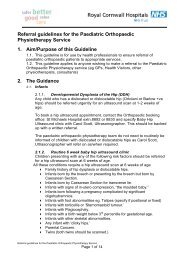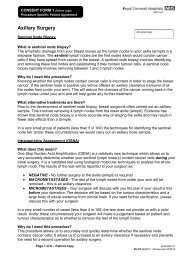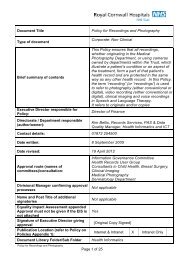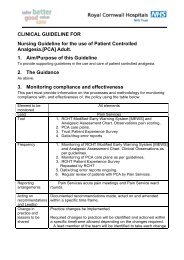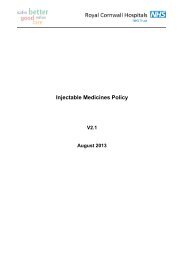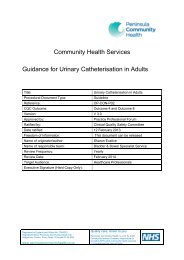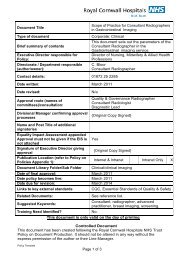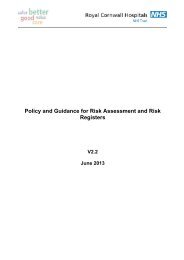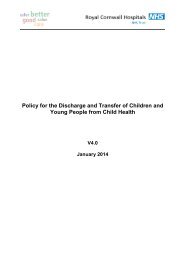Clinical Guideline for the Reporting of Clinical Imaging Examination ...
Clinical Guideline for the Reporting of Clinical Imaging Examination ...
Clinical Guideline for the Reporting of Clinical Imaging Examination ...
You also want an ePaper? Increase the reach of your titles
YUMPU automatically turns print PDFs into web optimized ePapers that Google loves.
CLINICAL GUIDELINE FOR THE REPORTING OF CLINICALIMAGING EXAMINATIONS AND PROCEDURES1.0 Aim & PurposeThis document is applicable to <strong>the</strong> reporting <strong>of</strong> imaging and procedures undertaken by <strong>the</strong><strong>Clinical</strong> <strong>Imaging</strong> Team. It is inclusive <strong>of</strong> <strong>for</strong>mal reporting and red dot reporting but excludesobstetric reporting as part <strong>of</strong> <strong>the</strong> NHS Foetal Anomaly Screening Programme. Thepurpose <strong>of</strong> <strong>the</strong> document is to clarify <strong>the</strong> level <strong>of</strong> image interpretation and <strong>the</strong> staff groupsinvolved. The document also provides guidance on <strong>the</strong> structure and content <strong>of</strong> reporting.2.0 The Guidance2.1 ResponsibilitiesAccording to documentation from <strong>the</strong> Royal College <strong>of</strong> Radiologists (2012):It is <strong>the</strong> responsibility <strong>of</strong> <strong>the</strong> reporting practitioner to ensure that <strong>the</strong> reports aretimely, clear and precise; to clearly document advice on fur<strong>the</strong>r management oraction, where appropriate; and ensure <strong>the</strong> urgency <strong>for</strong> action is documentedwithin <strong>the</strong> content <strong>of</strong> <strong>the</strong> report.It is <strong>the</strong> responsibility <strong>of</strong> <strong>the</strong> referrer/referring team to read and act upon <strong>the</strong>result <strong>of</strong> every investigation it generates2.2 Definitions<strong>Reporting</strong>: <strong>Reporting</strong> describes <strong>the</strong> provision <strong>of</strong> a clinical opinion throughconsideration <strong>of</strong> <strong>the</strong> medical history, presenting signs and symptoms declared by <strong>the</strong>referrer, <strong>the</strong> appropriateness/ limitations <strong>of</strong> <strong>the</strong> imaging method, and observation anddescription <strong>of</strong> normal and abnormal findings to enable <strong>the</strong> referring practitioner tomake an in<strong>for</strong>med decision regarding patient management.The Royal College <strong>of</strong> Radiologists gives <strong>the</strong> following definitions:Critical Findings: Where emergency action is required as soon as possibleUrgent Findings: Where medical evaluation is required within 24 hours<strong>Clinical</strong> <strong>Guideline</strong> <strong>for</strong> <strong>the</strong> <strong>Reporting</strong> <strong>of</strong> <strong>Clinical</strong> <strong>Imaging</strong> <strong>Examination</strong> and ProceduresPage 1 <strong>of</strong> 11
Significant Unexpected Findings: Where <strong>the</strong> reporting practitioner has concernsthat <strong>the</strong> findings are significant <strong>for</strong> <strong>the</strong> patient and may be unexpected by <strong>the</strong> referrer.2.3 Staff Groups2.3.1 <strong>Reporting</strong> PractitionersConsultant RadiologistsSpecialist RegistrarsConsultant GI Radiographer acting within approved scope <strong>of</strong> practice (CI.IR.04& CI.IR.01)Consultant Breast <strong>Imaging</strong> Radiographer acting within approved scope <strong>of</strong>practice (CI.MER.01)Sonographers acting in accordance with local protocols (CI.US)Advanced Practitioners (<strong>Reporting</strong> Radiographers) in plain film reporting actingwithin agreed scope <strong>of</strong> practice (CI.TAG.07)MRI practitioners who exclude intra orbital <strong>for</strong>eign bodies (refer to 2.7.2)2.4 Structure and Content <strong>of</strong> ReportsA report is an assessment <strong>of</strong> <strong>the</strong> examination/procedure and may also include adviceregarding patient management. According to <strong>the</strong> Royal College <strong>of</strong> Radiologists(2006) <strong>the</strong> usual <strong>for</strong>mat <strong>of</strong> reports will include:<strong>Clinical</strong> detailsA description <strong>of</strong> <strong>the</strong> findingsA conclusion or interpretation <strong>of</strong> findings in <strong>the</strong> clinical contextFor long or complex reports <strong>the</strong>re should be a conclusion at <strong>the</strong> end <strong>of</strong> <strong>the</strong>report which answers <strong>the</strong> clinical question in <strong>the</strong> request2.4.1 Quality, Accuracy and Verification <strong>of</strong> ReportsEach reporting practitioner is responsible <strong>for</strong> <strong>the</strong> quality and accuracy <strong>of</strong> <strong>the</strong>ir work.Reports are generated using voice recognition (VR) or typed directly onto <strong>the</strong>Computer Radiology In<strong>for</strong>mation System (CRIS). It is <strong>the</strong> responsibility <strong>of</strong> <strong>the</strong>practitioner to check accuracy and readability be<strong>for</strong>e verifying <strong>the</strong> report. The reportis <strong>the</strong>n released to CRIS, InSight PACS (including InSight Web), MAXIMS and <strong>the</strong>patient’s GP practice.<strong>Clinical</strong> <strong>Guideline</strong> <strong>for</strong> <strong>the</strong> <strong>Reporting</strong> <strong>of</strong> <strong>Clinical</strong> <strong>Imaging</strong> <strong>Examination</strong> and ProceduresPage 2 <strong>of</strong> 11
Consultant Radiologists are viewed as <strong>the</strong> experts and all practitioners must refer to<strong>the</strong>m where any doubt exists and a second opinion is needed. Non-medical reportersreceive specific, specialist training to prepare <strong>the</strong>m <strong>for</strong> <strong>the</strong> role. As part <strong>of</strong> thisassessment a Consultant Radiologist verifies reports during both training and asupervised period following qualification. A Consultant Radiologist has <strong>the</strong> authorityto check and verify reports <strong>of</strong> all non- medical practitioners.2.5 Communication <strong>of</strong> Findings & Safety Net Procedures.Each referrer/referring team is responsible <strong>for</strong> reading and acting upon <strong>the</strong> result <strong>of</strong>every investigation <strong>the</strong>y generate (RCR, 2012 & NPSA 2007).It is <strong>the</strong> responsibility <strong>of</strong> <strong>the</strong> Reporter to ensure that <strong>the</strong> referring Clinician, or ano<strong>the</strong>rappropriate member <strong>of</strong> <strong>the</strong> clinical team is contacted if <strong>the</strong>y consider that <strong>the</strong>re is adanger <strong>of</strong> unexpected relevant in<strong>for</strong>mation contained in <strong>the</strong> report not being actedupon (RCR, 2012).All reports are constructed on CRIS and once verified, are automaticallycommunicated to <strong>the</strong> referrer electronically, via <strong>the</strong> InSight Web, <strong>Clinical</strong> Care andMaxims systems; electronic reports are also sent to GPs via <strong>the</strong> GP link. Papercopies (known as white copies) are currently sent to Consultants, Wards and <strong>the</strong>Emergency Department; however this practice is reducing due to electronic systems.For reports which contain Critical, Urgent, or Unexpected Significant findings, <strong>the</strong>following additional Safety Net procedures should be followed.2.5.1 Critical FindingsFor immediately life-threatening conditions (e.g. life-threatening intracranialhaemorrhage, tension pneumothorax), where emergency action is required as soonas possible, <strong>the</strong> referring clinician or an appropriate member <strong>of</strong> <strong>the</strong>ir team should benotified directly by telephone or in person.2.5.2 Urgent FindingsFor true on call/emergency cases <strong>the</strong> referring doctor has a responsibility to pursueand review <strong>the</strong> result, given that by definition <strong>the</strong> patient’s acute management will bedetermined by <strong>the</strong> result <strong>of</strong> <strong>the</strong> scan e.g. head injury scan from A&E. Never<strong>the</strong>less,<strong>for</strong> urgent conditions where medical evaluation is required within 24 hours, and, in<strong>the</strong> clinical judgement <strong>of</strong> <strong>the</strong> reporter, <strong>the</strong>re is a concern that <strong>the</strong> report will not beviewed in a timely manner (e.g. incidental pulmonary embolus discovered on an<strong>Clinical</strong> <strong>Guideline</strong> <strong>for</strong> <strong>the</strong> <strong>Reporting</strong> <strong>of</strong> <strong>Clinical</strong> <strong>Imaging</strong> <strong>Examination</strong> and ProceduresPage 3 <strong>of</strong> 11
inpatient CT be<strong>for</strong>e a weekend, or on an outpatient referral) <strong>the</strong> reporter or delegateddeputy should notify <strong>the</strong> referrer/referring team <strong>of</strong> <strong>the</strong> report.2.5.3 Unexpected Significant FindingsFor unexpected findings which do not require an urgent change in management butwhich are very important <strong>for</strong> <strong>the</strong> future care <strong>of</strong> <strong>the</strong> patient. (e.g. incidental lung canceron CXR per<strong>for</strong>med <strong>for</strong> an unrelated indication), it is <strong>the</strong> responsibility <strong>of</strong> <strong>the</strong> reportingpractitioner or <strong>the</strong>ir nominated deputy to bring <strong>the</strong> report to <strong>the</strong> referrer/referringteam’s attention if, in <strong>the</strong>ir clinical judgement, <strong>the</strong>re is a danger that <strong>the</strong> report will notbe viewed in a timely manner. The reporter may recommend <strong>the</strong> next actionsfollowing such a finding (i.e. in this example referral to a chest physician) but mustnot take responsibility <strong>for</strong> such referrals or <strong>the</strong> ordering <strong>of</strong> fur<strong>the</strong>r examinations; <strong>the</strong>accountability lies with <strong>the</strong> team managing <strong>the</strong> patient’s care.The communication <strong>of</strong> unexpected significant results may be delegated to a member<strong>of</strong> <strong>the</strong> <strong>Clinical</strong> <strong>Imaging</strong> Administration Team at <strong>the</strong> judgement <strong>of</strong> <strong>the</strong> reporter.For all MIU referrals with unexpected significant findings, <strong>the</strong> reporting clinicianshould take appropriate measures in order to ensure that <strong>the</strong> patient’s GP is notified.2.5.4 Recording communication <strong>of</strong> results.Where results are communicated verbally to <strong>the</strong> referrer or an appropriate member <strong>of</strong><strong>the</strong>ir team by <strong>the</strong> reporter, <strong>the</strong> telephoned result should be recorded on <strong>the</strong> report asan addendum, giving <strong>the</strong> date, time, name and role <strong>of</strong> <strong>the</strong> person who received <strong>the</strong>report.Where communication <strong>of</strong> results is delegated to <strong>the</strong> <strong>Clinical</strong> <strong>Imaging</strong> AdministrationTeam, <strong>the</strong> report should be placed in <strong>the</strong> ‘Admin Action’ folder on InSight Web, alongwith a brief description <strong>of</strong> <strong>the</strong> action required. The Administration Team log <strong>the</strong>following details from <strong>the</strong>se actions in an Excel database:Patient nameCR numberProcedureReporterGP/Consultant’s Team/Wardcontact details<strong>Clinical</strong> <strong>Guideline</strong> <strong>for</strong> <strong>the</strong> <strong>Reporting</strong> <strong>of</strong> <strong>Clinical</strong> <strong>Imaging</strong> <strong>Examination</strong> and ProceduresPage 4 <strong>of</strong> 11Date & time <strong>of</strong> communicationPA who made <strong>the</strong> telephonecallAny additional commentsA note <strong>of</strong> <strong>the</strong> telephone communication is also made in <strong>the</strong> comments box on <strong>the</strong>patient’s CRIS record.
2.5.5 Communicating Findings Directly with <strong>the</strong> PatientThe communication <strong>of</strong> results with <strong>the</strong> patient must be sensitive and honest. Resultsshould only be discussed if <strong>the</strong> images have been fully reviewed and <strong>the</strong> individualfeels competent and it is appropriate to in<strong>for</strong>m <strong>the</strong> patient including answering anyquestions regarding ongoing care/management.2.6 <strong>Reporting</strong> Images <strong>of</strong> <strong>the</strong> DeceasedDeceased paediatric patients (17 years and under): investigations must be reported.Deceased adult patients (aged 18 and over): <strong>the</strong> investigations will not be analysed.The following statement will be placed with <strong>the</strong> image(s).'Patient deceased at <strong>the</strong> time <strong>of</strong> reporting; if you require <strong>the</strong>se images to be reportedplease contact <strong>the</strong> x-ray dept.'The department will review images by request.2.7 Images Which Do Not Receive <strong>Clinical</strong> Evaluation by <strong>the</strong><strong>Imaging</strong> DepartmentIt is a statutory requirement <strong>of</strong> IR(ME)R that all examinations involving ionisingradiation are evaluated in <strong>the</strong> clinical record, ei<strong>the</strong>r in <strong>the</strong> <strong>for</strong>m <strong>of</strong> a report by aRadiologist or an opinion by ano<strong>the</strong>r clinician.2.7.1 <strong>Reporting</strong> Arrangements in O<strong>the</strong>r SpecialitiesBy agreement with <strong>the</strong> relevant clinical specialities <strong>the</strong> following examinations will notbe routinely reported by <strong>the</strong> clinical imaging department and <strong>the</strong> clinician's evaluation<strong>of</strong> <strong>the</strong> examination will be documented in <strong>the</strong> patient's clinical record:1) Non-paediatric orthopaedic plain radiographs from Orthopaedic wards, <strong>the</strong>atresand outpatient clinics including fracture clinic. EXCEPTIONS: chest and abdominalradiographs, requests from Physio<strong>the</strong>rapist and o<strong>the</strong>r non-medical practitioners.2) Orthodontic examinations (OPG and occlusal views) requested by <strong>the</strong> orthodonticdepartmentThe referring team can specifically request a radiologist report on any examination. Ifthis is made at <strong>the</strong> time <strong>of</strong> request <strong>the</strong> examination should be allocated to REFHOT.<strong>Clinical</strong> <strong>Guideline</strong> <strong>for</strong> <strong>the</strong> <strong>Reporting</strong> <strong>of</strong> <strong>Clinical</strong> <strong>Imaging</strong> <strong>Examination</strong> and ProceduresPage 5 <strong>of</strong> 11
2.7.2 Pre- MRI Intra-Orbital Foreign Body ImagesFor radiographs to exclude <strong>the</strong> presence <strong>of</strong> <strong>for</strong>eign bodies within <strong>the</strong> eye which mayprohibit <strong>the</strong> patient from undergoing an MRI scan, MRI practitioners who have beendeemed competent will provide a report related to <strong>the</strong> presence <strong>of</strong> <strong>for</strong>eign body only.Fur<strong>the</strong>r reporting is available by request.2.8 Location and Storage2.8.1 ReportsAll <strong>Clinical</strong> <strong>Imaging</strong> reports are held on <strong>the</strong> Computer Radiology In<strong>for</strong>mation System(CRIS) and are available to view on <strong>the</strong> InSight Web system with <strong>the</strong> exception <strong>of</strong>NHS Foetal Anomaly Screening.2.9 ReferencesNational Patient Safety Agency (2007) Safer Practice Notice 16: EarlyIdentification Of Failure To On Radiological <strong>Imaging</strong> Reports.Accessed at:http://www.nrls.npsa.nhs.uk/EasySiteWeb/getresource.axd?AssetID=61469&..Royal College <strong>of</strong> Radiologists (2006) Standards <strong>for</strong> <strong>the</strong> <strong>Reporting</strong> andInterpretation <strong>of</strong> <strong>Imaging</strong> Investigations. London: RCR.Accessed at:http://www.rcr.ac.uk/docs/radiology/pdf/Standards<strong>for</strong><strong>Reporting</strong>andInetrpwebvers.pdfRoyal College <strong>of</strong> Radiologists (2012) Standards <strong>for</strong> <strong>the</strong> Communication <strong>of</strong> Critical,Urgent and Unexpected Significant Radiological Findings (2 nd Edition). London:RCR.Accessed at: http://www.rcr.ac.uk/docs/radiology/pdf/BFCR(12)11_urgent.pdfRoyal College <strong>of</strong> Radiologists (2011) Standards and Recommendations <strong>for</strong> <strong>the</strong><strong>Reporting</strong> and Interpretation <strong>of</strong> <strong>Imaging</strong> Investigations by Non-RadiologistMedically Qualified Practitioners and Teleradiologists. (2 nd Edition) London:RCR.Accessed at: http://www.rcr.ac.uk/docs/radiology/pdf/BFCR(11)2_<strong>Reporting</strong>.pdf<strong>Clinical</strong> <strong>Guideline</strong> <strong>for</strong> <strong>the</strong> <strong>Reporting</strong> <strong>of</strong> <strong>Clinical</strong> <strong>Imaging</strong> <strong>Examination</strong> and ProceduresPage 6 <strong>of</strong> 11
3.0 Monitoring compliance and effectivenessElement to be<strong>Reporting</strong> standardsmonitoredLeadToolFrequency<strong>Reporting</strong>arrangementsActing onrecommendationsand Lead(s)Change inpractice andlessons to besharedDr P. CookAudit <strong>of</strong> reporting accuracy within imaging & audit <strong>of</strong> documentedevaluation by departments outside <strong>of</strong> imaging.AnnualReport to clinical imaging audit meetingThe lead will act on urgent findings immediately, any discussions/recommendation will be documented through <strong>the</strong> minutes <strong>of</strong> <strong>the</strong>clinical imaging audit meeting.Actions will be taken by <strong>the</strong> Lead, changes in practice will bereflected within this document. Lessons learned will be shared andimplemented through <strong>the</strong> clinical imaging audit meeting.4.0 Equality and DiversityThis document complies with <strong>the</strong> Royal Cornwall Hospitals NHS Trust service Equality andDiversity statement.4.1Equality Impact AssessmentThe Initial Equality Impact Assessment Screening Form is at Appendix 2.<strong>Clinical</strong> <strong>Guideline</strong> <strong>for</strong> <strong>the</strong> <strong>Reporting</strong> <strong>of</strong> <strong>Clinical</strong> <strong>Imaging</strong> <strong>Examination</strong> and ProceduresPage 7 <strong>of</strong> 11
Appendix 1. Governance In<strong>for</strong>mationDocument Title<strong>Clinical</strong> <strong>Guideline</strong> <strong>for</strong> <strong>the</strong> <strong>Reporting</strong> <strong>of</strong><strong>Clinical</strong> <strong>Imaging</strong> <strong>Examination</strong> andProceduresCI.GEN.19Date Issued/Approved: 30 September 2013Date Valid From: 30 September 2013Date Valid To: 1 st September 2016Directorate / Department responsible(author/owner):Dr P. Cook, Speciality Lead, <strong>Clinical</strong><strong>Imaging</strong>Contact details: 01872 252285Brief summary <strong>of</strong> contentsThis guideline relates to <strong>the</strong> content anddelivery <strong>of</strong> reporting <strong>of</strong> radiographicimages or procedures undertaken by <strong>the</strong>clinical imaging team.Suggested Keywords:Target AudienceExecutive Director responsible <strong>for</strong>Policy:X-ray, reporting, radiologists, imagingRCHT PCT CFTMedical DirectorDate revised: June 2016This document replaces (exact title <strong>of</strong>previous version):Approval route (names <strong>of</strong>committees)/consultation:<strong>Clinical</strong> <strong>Guideline</strong> <strong>for</strong> <strong>the</strong> <strong>Reporting</strong> <strong>of</strong><strong>Clinical</strong> <strong>Imaging</strong> <strong>Examination</strong> andProcedures<strong>Clinical</strong> <strong>Imaging</strong> <strong>Clinical</strong> GovernanceDivisional Manager confirmingapproval processesName and Post Title <strong>of</strong> additionalsignatoriesSignature <strong>of</strong> Executive Director givingapprovalPublication Location (refer to Policyon Policies – Approvals andRatification):Document Library Folder/Sub FolderLinks to key external standardsBruce Daniel, Divisional ManagerEmma Spouse, Diagnostics Lead{Original Copy Signed}Internet & Intranet<strong>Clinical</strong> / <strong>Clinical</strong> <strong>Imaging</strong> Intranet OnlyIonising Radiation (Medical Exposure)Regulations<strong>Clinical</strong> <strong>Guideline</strong> <strong>for</strong> <strong>the</strong> <strong>Reporting</strong> <strong>of</strong> <strong>Clinical</strong> <strong>Imaging</strong> <strong>Examination</strong> and ProceduresPage 8 <strong>of</strong> 11
Related Documents:Training Need Identified?RCHT Radiation Safety PolicyNoVersion Control TableDateVersionNoSummary <strong>of</strong> ChangesNov 11 V1.0 Initial Issue18/6/2013 V2.027/8/2013 V3.0Updated to reflect changes in imaging PACSsystemUpdated document to include reportsexcluded from <strong>the</strong> document.Changes Made by(Name and Job Title)Naomi BurdenGovernanceRadiographerNaomi BurdenGovernanceRadiographerNaomi BurdenGovernanceRadiographerAll or part <strong>of</strong> this document can be released under <strong>the</strong> Freedom <strong>of</strong> In<strong>for</strong>mationAct 2000This document is to be retained <strong>for</strong> 10 years from <strong>the</strong> date <strong>of</strong> expiry.This document is only valid on <strong>the</strong> day <strong>of</strong> printingControlled DocumentThis document has been created following <strong>the</strong> Royal Cornwall Hospitals NHS TrustPolicy on Document Production. It should not be altered in any way without <strong>the</strong>express permission <strong>of</strong> <strong>the</strong> author or <strong>the</strong>ir Line Manager.<strong>Clinical</strong> <strong>Guideline</strong> <strong>for</strong> <strong>the</strong> <strong>Reporting</strong> <strong>of</strong> <strong>Clinical</strong> <strong>Imaging</strong> <strong>Examination</strong> and ProceduresPage 9 <strong>of</strong> 11
Appendix 2.Initial Equality Impact Assessment ScreeningForm<strong>Clinical</strong> <strong>Guideline</strong> <strong>for</strong> <strong>the</strong> <strong>Reporting</strong> <strong>of</strong> <strong>Clinical</strong> <strong>Imaging</strong> <strong>Examination</strong> and ProceduresCI.GEN.19Directorate and service area:Is this a new or existing Procedure?<strong>Clinical</strong> <strong>Imaging</strong>ExistingName <strong>of</strong> individual completingTelephone:assessment: Naomi Burden018722550861. Policy Aim* To clarify reporting processes <strong>for</strong> imaging examinations andprocedures.2. Policy Objectives* To ensure <strong>the</strong> reporter fully understands <strong>the</strong>ir responsibilitieswhen requesting medical imaging.3. Policy – intendedOutcomes*2 How will you measure<strong>the</strong> outcome?• Clear standards in placeo Local document which reflects <strong>the</strong> requirements <strong>of</strong> <strong>the</strong>law in relation to ionising radiationThrough audit and monitoring5. Who is intended tobenefit from <strong>the</strong> Policy?6a. Is consultationrequired with <strong>the</strong>work<strong>for</strong>ce, equalitygroups, local interestgroups etc. around thispolicy?Staff and patientsNob. If yes, have <strong>the</strong>segroups been consulted?c. Please list any groupswho have been consultedabout this procedure.*Please see Glossary7. The ImpactPlease complete <strong>the</strong> following table.Are <strong>the</strong>re concerns that <strong>the</strong> policy could have differential impact on:Equality Strands: Yes No Rationale <strong>for</strong> Assessment / Existing EvidenceAge x There is no impact on this groupSex (male, female, transgender/ genderreassignment)Race / Ethniccommunities /groupsxxThere is no impact on this groupThere is no impact on this group<strong>Clinical</strong> <strong>Guideline</strong> <strong>for</strong> <strong>the</strong> <strong>Reporting</strong> <strong>of</strong> <strong>Clinical</strong> <strong>Imaging</strong> <strong>Examination</strong> and ProceduresPage 10 <strong>of</strong> 11
Disability -learningdisability, physicaldisability, sensoryimpairment andmental healthproblemsReligion /o<strong>the</strong>r beliefsMarriage and civilpartnershipxxxThere is no impact on this groupThere is no impact on this groupThere is no impact on this groupPregnancy and maternity x There is no impact on this groupSexual Orientation,x There is no impact on this groupBisexual, Gay, heterosexual,LesbianYou will need to continue to a full Equality Impact Assessment if <strong>the</strong> following have beenhighlighted:You have ticked “Yes” in any column above andNo consultation or evidence <strong>of</strong> <strong>the</strong>re being consultation- this excludes any policieswhich have been identified as not requiring consultation. orMajor service redesign or development8. Please indicate if a full equality analysis is recommended. Yes No9. If you are not recommending a Full Impact assessment please explain why.Signature <strong>of</strong> policy developer / lead manager / directorDate <strong>of</strong> completion and submissionNames and signatures <strong>of</strong>members carrying out <strong>the</strong>Screening Assessment1.2.Keep one copy and send a copy to <strong>the</strong> Human Rights, Equality and Inclusion Lead,c/o Royal Cornwall Hospitals NHS Trust, Human Resources Department, Knowledge Spa,Truro, Cornwall, TR1 3HDA summary <strong>of</strong> <strong>the</strong> results will be published on <strong>the</strong> Trust’s web site.Signed _______________Date ________________<strong>Clinical</strong> <strong>Guideline</strong> <strong>for</strong> <strong>the</strong> <strong>Reporting</strong> <strong>of</strong> <strong>Clinical</strong> <strong>Imaging</strong> <strong>Examination</strong> and ProceduresPage 11 <strong>of</strong> 11




